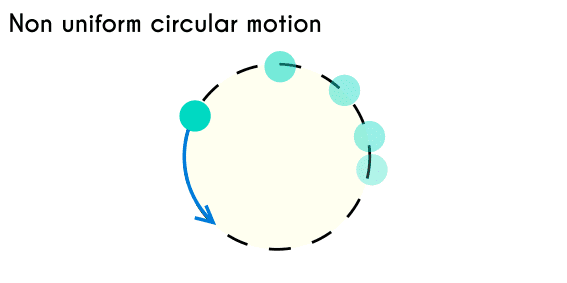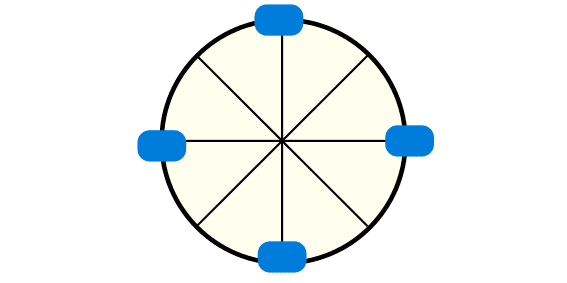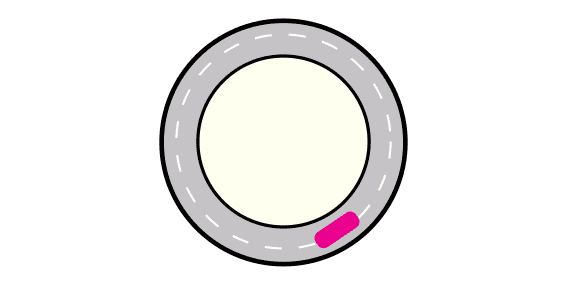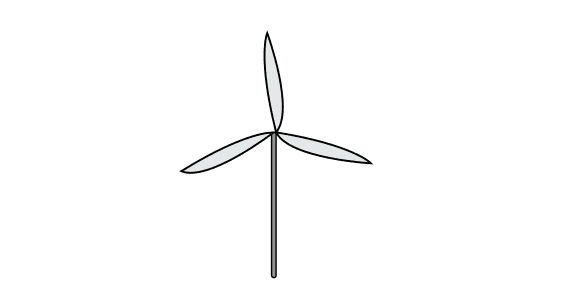Non uniform circular motion with examples
This article will be about The main characteristics of a non uniform circular motion, with examples and formulas.
Non uniform circular motion
The non uniform circular motion is a motion that is characterized for having a circular trajectory and the tangential and the angular velocity is increasing or decreasing constantly. (it will depend on the direction of each acceleration). In the non uniform circular motion there are 3 types of accelerations: angular acceleration, tangential acceleration and centripetal acceleration, this makes the magnitude and direction of the vector to change constantly.
As we said, in a non uniform circular motion there are various velocities and accelerations, this is why we must know every concept of velocity and acceleration: the velocity of an object defines how much an object covers in terms of distance in a period of time, while the acceleration is the permanent change of the velocity, for instance, if the acceleration of an object is 1m/s, this means that the velocity will be 1m/s faster every second, the thing here is that in a circular motion there are multiple accelerations that not only changes the magnitude of the velocity, but also the direction and is this that makes that the object move in circles.
Velocities and accelerations of a non uniform circular motion
The circular motion in general is separated in two parts, the angular part and the tangential part. The angular part of a problem is everything that has to do with the rotation or orbit of an object, the velocity of rotation of the object and the angular acceleration. When we are working on this part of the circular motion, the longitude measures does not matter, here we are only focusing on the angular magnitudes. Meanwhile the tangential part of the circular motion is everything that has to do with longitude, for example, the distance that an object covered, the velocity of an object and the acceleration of the object. Even when both parts, tangential and angular, are worked separately, there are equations that allows us to pass from one environment to the other, so we can solve the full problem even when we only have data from one of the parts.

Angular acceleration (α): is the increase or decrease of the angular velocity, this acceleration is constant and is expressed in rad/s2.
Angular velocity(ω): this velocity defines the radians that a body rotates in a period of time, in non uniform circular motion there is always going to be an initial and a final angular velocity, this is represented by the symbol ω and it is expressed in rad/s.
Tangential acceleration (At): this is the type of acceleration we find in rectilinear motions, this increases or decreases the velocity of an object, and it is expressed in m/s2
Tangential velocity (Vt) is the longitude that an object advances in a period of time, this velocity changes its velocity and magnitude constantly. Like the angular velocity, the tangential velocity in a non uniform circular motion is always going to have and initial and a final velocity this is expressed in m/s and is represented by the letter Vt
Centripetal acceleration (Ac): this acceleration is the one that makes the direction of the velocity of an object change in a non uniform circular motion.
Non uniform circular motion formulas
As we said before, the angular and the tangential sides work separately, but the equation we use are basically the same, they just change the types of variables, and this are pretty much like the uniformly accelerated motion formulas.
S = distance that an object covers in the circumference.
- Tangential equations
- At = Vf - Vot
- S = Vo * t + 12* At * t2
- Vf2 = Vo2 + 2 * At * S
- S = ( Vo + Vf2) * t
- Angular equations
- α = ωf - ωot
- Θ = ωo * t + 12* α * t2
- ωf2 = ωo2 + 2 * α * Θ
- Θ = ( ωo + ωf2) * t
In a non uniform circular motion every tangential magnitude can be found based on the same angular magnitude, we just have to multiply it by the radius of the circle, for example, the tangential velocity can be found by multiplying the angular velocity by the radius.
- From angular to tangetial
- Vf = ωf * R
- Vo = ωo * R
- At = α * R
- S = Θ * R
- From tangetial to angular
- ωf = VfR
- ωo = VoR
- α = AtR
- Θ =SR
Examples of this circular motion
Example 1: A Ferris wheel has a radius of 5 meters and it starts at a velocity of 0rad/s, after 30 seconds the wheel reaches a velocity of 0.2rad/s, what is the angular acceleration applied and the tangential velocity in that moment.

- We write the formula and solve
- α = ωf - ωot
- α = 0.2 - 030
- a = 0.0067 rad/s
As we showed before, any variable can be converted just by multiplying the data by the radius.
- Now we find the tangetial velocity
- Vf = ωf * R
- Vf = 0.2 * 5
- a = 1 m/s
Example 2: A car is rotating on a rounded car track that has a diameter of 23 meters and it is going at an angular velocity of 0.5 rad/s, if we know that from that moment the driver accelerates 0.01rad/s for 2 seconds, calculate the total radians that he rotate and the distance.

First we find the radians
- We write the equation and solve
- Θ = ωo * t + 1/2 * a * t2
- Θ = 0.5 rad/s * 2 s + 1/2 * 0.01 rad/s2 * 2s2
- Θ = 1 rad + 1/2 * 0.01rad/s2 * 4s
- Θ = 1.02 rad
Now knowing this we can calculate the distance “S” by multiplying the radians by the radius of the track, the problem says that the diameter is of 23, but as we know the radius is the diameter divided by 2.
- We find the diameter
- R = diameter / 2
- R = 23 / 2
- R = 11.5
- And we find the distance S
- S = Θ * R
- S = 1.02 * 11.5
- S = 11.73 m
Example 3: The blades of a windmill is still because there is no wind on the place, but out of nowhere comes some wind, if the acceleration that the blades suffered was 0.05rad/s, calculate the time that it took to reach 4.2 rad/s

- We write the formula
- α = ωf - ωot
- and clear the time
- T = ωf - ωoα
- T = 4.2 - 00.05
- t = 84s